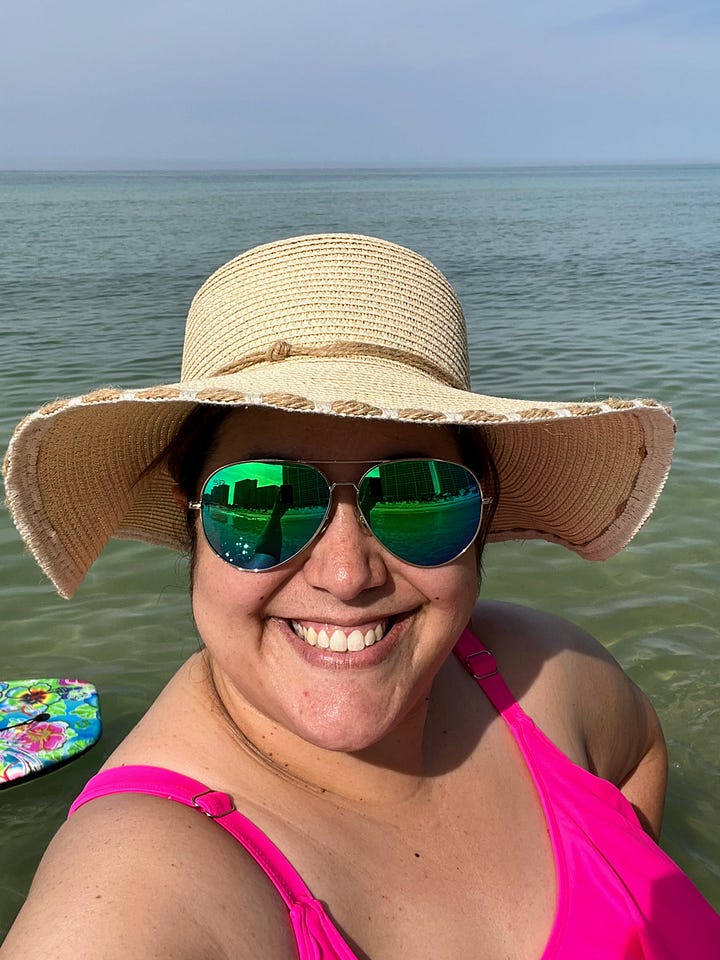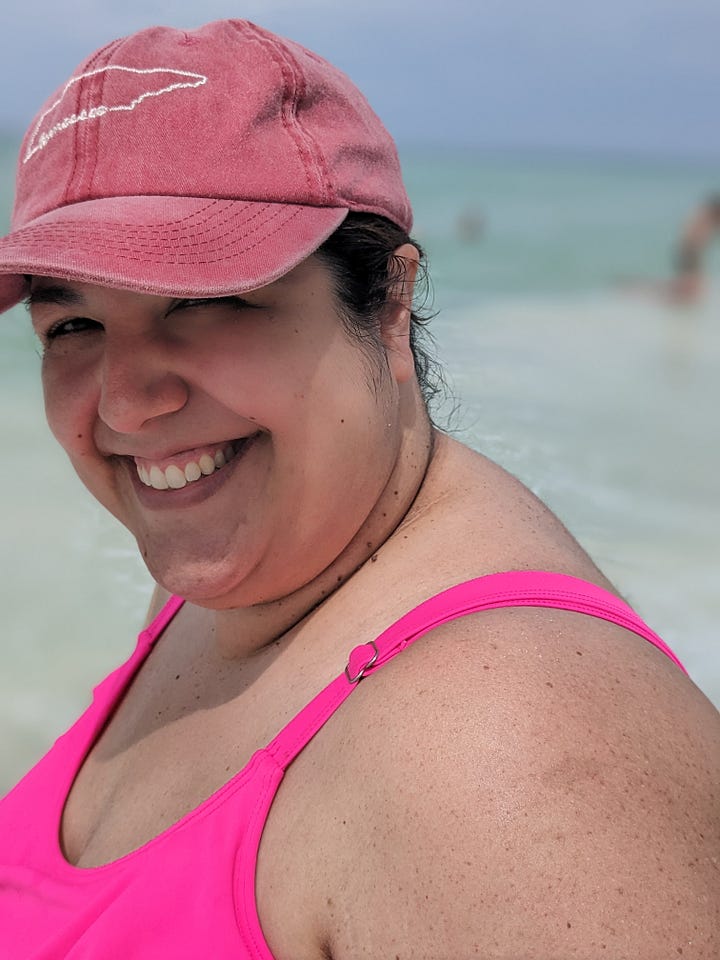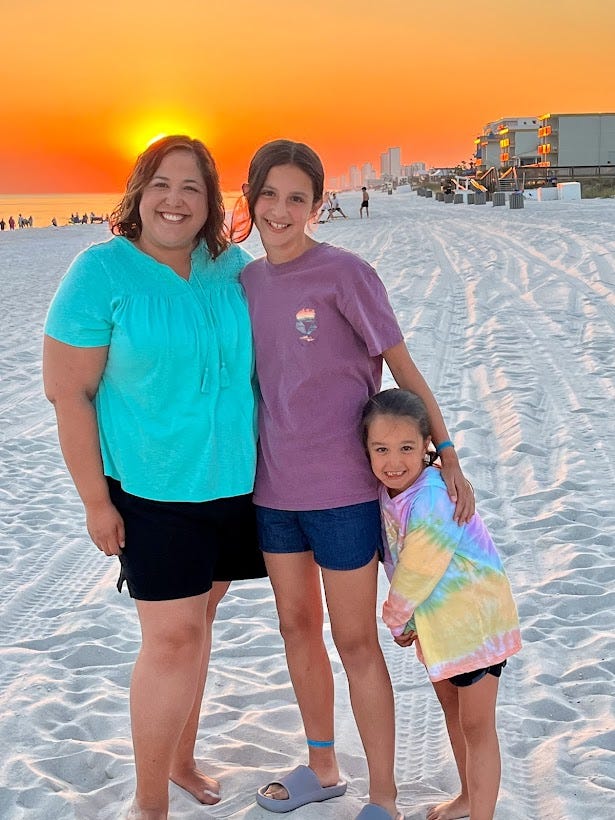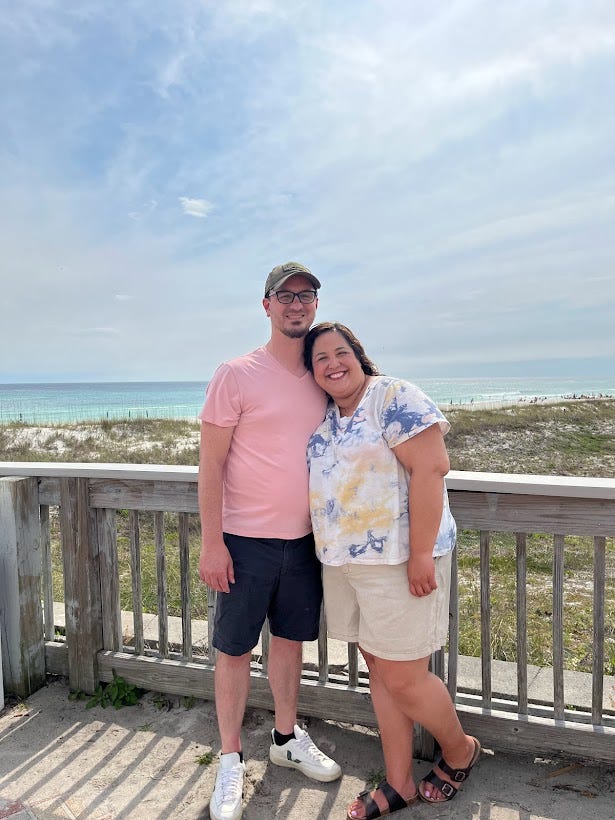Part 1 is here.
I wish I could tell you that smashing my scale in the fall of 2020 put an end to all of my negative thoughts about my body, but unfortunately (and probably not surprisingly), that was not the case. The thing about recovery is it’s rarely a straight line; more often than not peaks of progress are interrupted by valleys of struggle and heartache.
Such has been my experience with body image and body acceptance. I have had periods of time when the negative thoughts are not quite so loud, when I don’t cringe every time I look in the mirror, when I don’t spend half of my day fretting about my appearance. Last year my family went to the beach, and I spent a total of zero minutes worried about how I looked. I put on my bathing suit and played in the ocean and sunbathed and laughed and danced around with my girls and had the best time. A family from church had us over to their house to swim a few times, and even though spending time in a bathing suit with people outside of my family (or even inside my family) would have me riddled with anxiety for days leading up to it, last summer I just put on the suit and focused on enjoying being with our friends.
This year, we returned to the beach, but in the weeks leading up to the trip, I was simultaneously yearning for it and dreading it. I knew I would have to put on a bathing suit, and I didn’t want to. I even found myself hoping for a cold front to make wearing a sweatshirt on the beach in late May a necessity. When an email went out to my life group at church about an all-female swim party taking place in June, I immediately started thinking of ways to get out of it. Even among a group of women I called friends, I was horrified by the idea of spending time with them in a bathing suit. How could I focus on conversation when so much of me would be exposed? How could these women even be friends with me when most of them had seen me slowly but steadily regain all the weight I had lost?
The problem with all of these thoughts is that they were focused on how others would perceive me, or rather how I thought they would perceive me. I feared the judgment and disgust of people on the beach, people I didn’t know and would probably never see again. I convinced myself that my kind and loving friends would spend our time together in the pool inwardly critiquing every part of my body, even though they have never given me any reason to think this. When the pool party got rained out, I confess that my primary emotion was relief. The weather had saved me from a potentially embarrassing situation!
How many times have I let my fear and insecurity rob me of a good experience? How many times have I given the wrong voice power over me?
* * * * * * * * * * * * * * * * * * * * * * * * * * * * * * * * * * *
In April of 2019 I went to Timberline Knolls, a residential treatment facility outside of Chicago, to get extended treatment for the depression that had been my constant companion for months. (You can read more about that time here.) Part of my treatment involved group therapy, and one of the groups I attended was focused on body image. I don’t think I cried in any group as much as I cried in the body image group. Being in that group and talking about struggles I had kept mostly to myself for years stirred up lots of pain and sorrow, and I often felt overwhelmed. The fact that a group about body image affected me so deeply was somewhat mystifying since I came to TK to deal with suicidal thoughts, but the longer I stayed at TK, the more I realized that how I viewed my body directly affected my overall view of myself and my outlook on life. If my body was bad, then I was bad, and if I was bad, what was the point of living? Even though now I can recognize how illogical and theologically unsound these thoughts were, at the time I was so deep in the dark that I had a hard time seeing clearly.
One day at the body image group, the therapist handed all of us a worksheet that listed out different body parts: feet, arms, legs, hips, thighs, face, etc. Next to each body part we were supposed to list our distorted or negative thoughts about that body part, and in another column, things we liked or were thankful for about that part. I just stared at the sheet, thinking that this exercise was 1) stupid and 2) impossible. The minutes passed by, and I kept staring, trying to think of something—anything—to write down. It wasn’t hard to conjure up the negative thoughts I had about a lot of body parts; those came to me unbidden on a daily basis. But writing down words like “batlike” and “ugly” in reference to my arms and “giant” and “lumpy” in regards to my thighs was hard. The words were harsh and stark on the page, and I wanted to look away. I wanted to fill out that second column—the one where I was supposed to be grateful for my body—but how could I be grateful for something I had spent most of my life hating? Tears began to spill down my face, and the therapist came and knelt beside me and asked me what I was thinking. “I can’t do this,” I told her through my tears. “I don’t like any of this. I am not thankful for any of this,” I gestured to my body.
“What if instead of being thankful, you just appreciated your body?” she asked in reply, looking at me with kindness. “What has your body done for you? Think about that.”
What has my body done for me? I scoffed. Nothing good. It never looked the way I wanted it to. My gut was diseased. My hips caused me physical pain.
But then I thought about my daughters. I thought of the arms—my arms—that held them through sleepless nights and for countless snuggles, that had lifted car seats in and out of vehicles ad infinitum. I thought of the shoulders that their heads rested on when they were tired or sad. I thought of the legs that had allowed me to run a half marathon, that had carried me thousands of miles over the course of my life, that had supported me as I pushed a baby stroller. I thought of the hands that brushed away tears, lips that kissed boo-boos both real and imagined, a lap that spread wide in welcome of long-limbed little ones. I thought of the softness of my belly, a pillow for bedraggled heads. I thought of the way my hips curved to hold the weight of a fussy baby or a sleepy toddler.
Maybe, just maybe, I didn’t have to love my body. But maybe, just maybe, I could accept it.
* * * * * * * * * * * * * * * * * * * * * * * * * * * * * * * * * * *
A few months ago, I found myself once again in the office of a counselor. I could feel myself slipping back into dangerous territory, and I knew I needed to be proactive. “I’m not in a dark place, but it’s definitely murky,” I told a friend after a hard day. Early on in my time with the counselor I knew I needed help navigating my feelings about my body. Stephen came with me to some of the appointments, and we talked through various thought patterns and struggles I was having and how to work through them. After one session, Stephen went over a thought exercise the counselor had given us. One part of the exercise asked me to think of a time in Scripture when Jesus had shown compassion for someone’s body. I immediately thought of the woman in Mark 5 with the illness that had caused her to bleed for 12 years.1 She was an outcast, destitute after giving all she had in an attempt to be healed, and she was desperate. Just a touch of Jesus’ robe was enough to heal her, and instead of immediately continuing on his way to see the son of the religious leader Jairus, Jesus stops. After the woman revealed herself, he tells her to go in peace and that her faith has made her well.
This story has always been meaningful to me, and that night I sat with Stephen and thought of all she must have been thinking and feeling before that encounter with Jesus. Then the exercise asked me to think about the compassion of Jesus and to consider how He might have compassion on me. As Stephen read through the prompt, one phrase stuck out to me: “Jesus loves [me] including [my] body.” I even stopped him and asked him to repeat it. Jesus loves me including my body? In that moment I realized a thought I had long believed but never fully acknowledged: I thought Jesus loved me in spite of my body, not including my body. I always imagined Him looking at me, grimacing at my appearance, and then loving my heart, my inner person, in spite of all the reasons my outer body gave Him to look away. Isn’t that what Scripture says? That “man looks on the outward appearance, but the Lord looks on the heart”?2 Yes, the Bible does say that. But the Lord does not reject my outer appearance. He does not turn away in revulsion. He created me with love, fashioned me with care. His works are wonderful, not despicable.3 My body matters to Him. I will still have a body even in heaven.
Even though it is easy for me to think of God as compassionate toward others, somehow it has often been hard for me to imagine that same compassion directed at me. Yet day by day I am trying to live in light of the fact that I am beloved, body and all. Some days I remember my beloved status as a child of God more easily than other days, but I know that the more I expose myself to the truths of God’s Word, the more quickly I will be able to recognize and quiet the lies.
One day my girls will become women, and when they look back on their childhood I don’t want them to remember a mom who was always obsessed with how she looked and was enslaved to the opinions of others. I want them to remember a mom who loved out of the abundance of love she had received, who delighted in them just as she knew her Heavenly Father delighted in her. I want them to know they are loved—by me but most of all by their Creator, who spoke the word “good” over them, who spilled the blood of His son so He could call them “righteous” and “daughter.” In the end, the only words that matter are the ones that He speaks over us.




Mark 5:25-34
1 Samuel 16:7
Psalm 139:14





Thank you!
I love these words. They’re beautiful, raw, vulnerable and hard won. Thanks for sharing the messy middle, things that aren’t tied up with a bow. Good to see you fighting the good fight! 💛